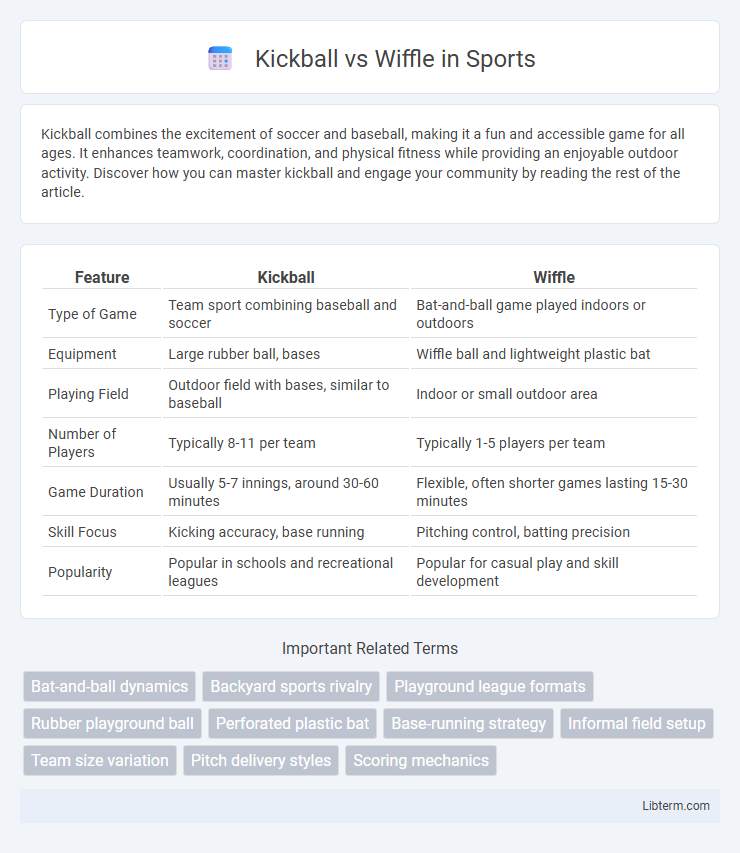Kickball combines the excitement of soccer and baseball, making it a fun and accessible game for all ages. It enhances teamwork, coordination, and physical fitness while providing an enjoyable outdoor activity. Discover how you can master kickball and engage your community by reading the rest of the article.
Table of Comparison
| Feature | Kickball | Wiffle |
|---|---|---|
| Type of Game | Team sport combining baseball and soccer | Bat-and-ball game played indoors or outdoors |
| Equipment | Large rubber ball, bases | Wiffle ball and lightweight plastic bat |
| Playing Field | Outdoor field with bases, similar to baseball | Indoor or small outdoor area |
| Number of Players | Typically 8-11 per team | Typically 1-5 players per team |
| Game Duration | Usually 5-7 innings, around 30-60 minutes | Flexible, often shorter games lasting 15-30 minutes |
| Skill Focus | Kicking accuracy, base running | Pitching control, batting precision |
| Popularity | Popular in schools and recreational leagues | Popular for casual play and skill development |
Introduction to Kickball and Wiffle Ball
Kickball is a playground game similar to baseball, played with a large rubber ball that players kick instead of hitting with a bat. Wiffle ball features a lightweight, perforated plastic ball and a curved plastic bat, designed for easy indoor and backyard play. Both sports emphasize active participation and teamwork but differ in equipment, gameplay speed, and field size.
Origins and History
Kickball originated in the early 20th century as a variation of baseball designed for younger players, gaining popularity in American schools during the 1940s. Wiffle ball was invented in 1953 by David N. Mullany to allow children to play baseball-style games in confined spaces using a lightweight, perforated plastic ball. Both games evolved as accessible, family-friendly alternatives to traditional baseball, reflecting cultural shifts towards inclusive and recreational sports.
Basic Rules Comparison
Kickball and Wiffle share similarities in basic gameplay, such as teams taking turns batting and fielding, but differ primarily in equipment and playing field. Kickball uses a larger rubber ball kicked by players toward bases, resembling baseball rules with running to score, while Wiffle is played with a lightweight plastic ball and bat designed for controlled pitching and hitting within a smaller field. Both games involve tagging and base running, but Wiffle emphasizes precision hitting and pitching mechanics more than kickball's focus on physical running and kicking skills.
Equipment and Field Setup
Kickball requires a larger, rubber playground ball approximately 8 to 10 inches in diameter and is typically played on a baseball diamond or open field with bases set 60 feet apart. Wiffle ball uses a lightweight, perforated plastic ball about 3 inches in diameter and a hollow plastic bat, played on a smaller field with bases closer together, often in backyards or smaller parks. The equipment and compact field setup of wiffle ball make it more accessible and suitable for limited space compared to the more extensive requirements of kickball.
Team Size and Player Roles
Kickball teams typically consist of 8 to 11 players, with roles including kicker, pitcher, catcher, and fielders responsible for covering bases and outfield areas. Wiffle ball, being a smaller-scale game, usually features teams of 2 to 5 players, with roles combining pitching, batting, and defensive fielding due to limited player numbers. The variation in team size and player roles between kickball and wiffle ball highlights the differences in gameplay dynamics and spatial requirements.
Game Strategy Differences
Kickball strategy emphasizes base running speed, territorial kicking, and team coordination to control field positioning and scoring opportunities. Wiffle ball strategy prioritizes pitch placement, ball spin manipulation, and quick reflexes to outmaneuver hitters within a smaller playing field. Both sports require distinct tactical approaches due to their unique equipment, field dimensions, and gameplay dynamics.
Physical Activity and Skill Levels
Kickball promotes cardiovascular endurance and leg strength through continuous running, kicking, and fielding, making it suitable for a wide range of physical fitness levels. Wiffle ball emphasizes hand-eye coordination, precision, and fine motor skills with its lightweight bat and perforated ball, requiring less intense physical exertion but higher technical skill. Both sports offer valuable physical activity benefits, with kickball favoring more aerobic and dynamic movement, while wiffle ball prioritizes controlled, strategic gameplay.
Accessibility and Popularity
Kickball offers broad accessibility due to its minimal equipment requirements, typically needing just a rubber ball and an open field, making it popular in schools and community leagues nationwide. Wiffle ball, while also accessible due to its lightweight plastic bat and perforated ball, is often favored for casual backyard play and smaller spaces, appealing to younger players and families. Popularity of kickball tends to peak in formal recreational leagues, whereas wiffle ball maintains steady popularity as a low-cost, easy-to-set-up game for all ages.
Pros and Cons of Each Game
Kickball offers a dynamic mix of soccer and baseball, promoting cardiovascular fitness and teamwork but requires a larger playing field and can be physically demanding. Wiffle ball is ideal for small spaces, using a lightweight plastic ball that reduces injury risk and allows for precise pitching, yet it may lack the vigorous physical activity found in kickball. Both games foster social interaction and coordination, with kickball emphasizing endurance and Wiffle ball focusing on skill and accuracy.
Which Game Is Right for You?
Kickball offers a fast-paced, team-oriented experience ideal for players who enjoy running, kicking, and competitive sports with a traditional ball and bases. Wiffle Ball provides a more casual, skill-focused game with a lightweight, perforated plastic ball that curves unpredictably, perfect for individuals seeking precision pitching and hitting in smaller spaces. Choosing between kickball and wiffle depends on your preference for physical activity, team size, and the play environment available.
Kickball Infographic

 libterm.com
libterm.com